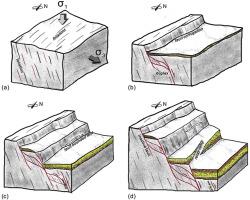当前位置:
X-MOL 学术
›
J. Struct. Geol.
›
论文详情
Our official English website, www.x-mol.net, welcomes your
feedback! (Note: you will need to create a separate account there.)
Formation of listric normal faults by extensional duplexing: A case study from the active Langshan piedmont fault, NW China
Journal of Structural Geology ( IF 2.6 ) Pub Date : 2020-11-01 , DOI: 10.1016/j.jsg.2020.104158 Heng Zhao , Jin Zhang , Junfeng Qu , Beihang Zhang , Long Yun , Pengfei Niu , Jie Hui , Yiping Zhang
Journal of Structural Geology ( IF 2.6 ) Pub Date : 2020-11-01 , DOI: 10.1016/j.jsg.2020.104158 Heng Zhao , Jin Zhang , Junfeng Qu , Beihang Zhang , Long Yun , Pengfei Niu , Jie Hui , Yiping Zhang

|
Abstract The development of normal faults is controlled by many factors, among which mechanical layers or pre-existing fabrics play an important role in the growth of normal faults. It is widely accepted that normal faults are rarely continuous surfaces but are zones composed of fault segments, heterogeneously distributed fault rocks of various compositions, slip bands, blocks and other deformation elements. Listric normal faults, particularly those developed in metamorphic crystalline rocks or preexisting fabric-developed basements, may be composed of subparallel faults in cross-sections, linked by extensional duplex structures. Here, we choose a listric rift-bounding fault rooted in foliation developed basements, the Langshan normal fault in the northwest corner of the Ordos Block, to conduct an outcrop analysis of fault geometry and linkage behavior from cross-sectional views. The Langshan normal fault zone is composed of mixed regions of high- and low-angle segments linked by duplex structures at various scales. Mylonitic foliations play a significant role in the formation of fault segments and the evolution of the listric fault zones. Lines of evidence show that small en echelon faults initiated from preexisting foliations. Local stress perturbation between overstepping faults results in the formation of duplex structures and displays a high fracture density, which serve to the coalesce of fault segments. Consequently, the progressive localization of strain onto a large listric fault is achieved by progressive development of extensional duplexing among fault segments in cross-sections. These extensional duplexes imply a scale-invariant property, based on which we can extrapolate this pattern occurs on larger scales and is verified by seismic data. The case of Langshan piedmont fault demonstrates the possibility of a listric fault being formed by subparallel planner faults and highlights the effects of preexisting fabrics on the evolution of listric faults, especially in basement fabrics developed regions along the fault.
更新日期:2020-11-01











































 京公网安备 11010802027423号
京公网安备 11010802027423号